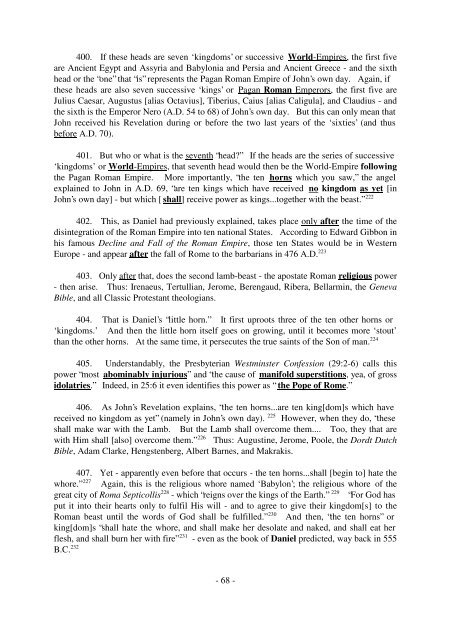JERUSALEM; ROME; REVELATION - The Preterist Archive
JERUSALEM; ROME; REVELATION - The Preterist Archive
JERUSALEM; ROME; REVELATION - The Preterist Archive
Create successful ePaper yourself
Turn your PDF publications into a flip-book with our unique Google optimized e-Paper software.
400. If these heads are seven ‘kingdoms’ or successive World-Empires, the first five<br />
are Ancient Egypt and Assyria and Babylonia and Persia and Ancient Greece - and the sixth<br />
head or the “one” that “is” represents the Pagan Roman Empire of John’s own day. Again, if<br />
these heads are also seven successive ‘kings’ or Pagan Roman Emperors, the first five are<br />
Julius Caesar, Augustus [alias Octavius], Tiberius, Caius [alias Caligula], and Claudius - and<br />
the sixth is the Emperor Nero (A.D. 54 to 68) of John’s own day. But this can only mean that<br />
John received his Revelation during or before the two last years of the ‘sixties’ (and thus<br />
before A.D. 70).<br />
401. But who or what is the seventh “head?” If the heads are the series of successive<br />
‘kingdoms’ or World-Empires, that seventh head would then be the World-Empire following<br />
the Pagan Roman Empire. More importantly, “the ten horns which you saw,” the angel<br />
explained to John in A.D. 69, “are ten kings which have received no kingdom as yet [in<br />
John’s own day] - but which [ shall] receive power as kings...together with the beast.” 222<br />
402. This, as Daniel had previously explained, takes place only after the time of the<br />
disintegration of the Roman Empire into ten national States. According to Edward Gibbon in<br />
his famous Decline and Fall of the Roman Empire, those ten States would be in Western<br />
Europe - and appear after the fall of Rome to the barbarians in 476 A.D. 223<br />
403. Only after that, does the second lamb-beast - the apostate Roman religious power<br />
- then arise. Thus: Irenaeus, Tertullian, Jerome, Berengaud, Ribera, Bellarmin, the Geneva<br />
Bible, and all Classic Protestant theologians.<br />
404. That is Daniel’s “little horn.” It first uproots three of the ten other horns or<br />
‘kingdoms.’ And then the little horn itself goes on growing, until it becomes more ‘stout’<br />
than the other horns. At the same time, it persecutes the true saints of the Son of man. 224<br />
405. Understandably, the Presbyterian Westminster Confession (29:2-6) calls this<br />
power “most abominably injurious” and “the cause of manifold superstitions, yea, of gross<br />
idolatries.” Indeed, in 25:6 it even identifies this power as “ the Pope of Rome.”<br />
406. As John’s Revelation explains, “the ten horns...are ten king[dom]s which have<br />
received no kingdom as yet” (namely in John’s own day). 225 However, when they do, “these<br />
shall make war with the Lamb. But the Lamb shall overcome them.... Too, they that are<br />
with Him shall [also] overcome them.” 226 Thus: Augustine, Jerome, Poole, the Dordt Dutch<br />
Bible, Adam Clarke, Hengstenberg, Albert Barnes, and Makrakis.<br />
407. Yet - apparently even before that occurs - the ten horns...shall [begin to] hate the<br />
whore.” 227 Again, this is the religious whore named ‘Babylon’; the religious whore of the<br />
great city of Roma Septicollis 228 - which “reigns over the kings of the Earth.” 229 “For God has<br />
put it into their hearts only to fulfil His will - and to agree to give their kingdom[s] to the<br />
Roman beast until the words of God shall be fulfilled.” 230 And then, “the ten horns” or<br />
king[dom]s “shall hate the whore, and shall make her desolate and naked, and shall eat her<br />
flesh, and shall burn her with fire” 231 - even as the book of Daniel predicted, way back in 555<br />
B.C. 232<br />
- 68 -
















